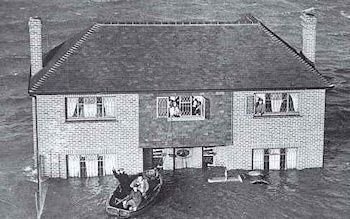
Sea Defences

The parish of Great Wakering is in a low lying area below sea level and very prone to flooding as storms sweep in from the North Sea causing tidal surges and huge waves with them. Wind has probably the biggest influence but there are many other factors. Barometric pressure also has an influence. A fall in pressure allows the tide to rise and a high wind from the Northerly quarters pushes the tide down the East Coast - this would normally pass through the Straits of Dover into the English Channel.
As the Straits are only twenty two miles wide this causes the tide to back up in this area and creates a funnel effect. We are in the top part of the funnel which causes a rapid increase in the tidal height causing the tide to overtop the seawalls and flood homes, businesses and highly fertile farmland.
The floods of 1953
The worst floods on record occurred at the end of January 1953 when the area was very badly hit. Nine people in Great Wakering lost their lives as large areas were flooded, many homes were flooded and many head of cattle perished. Those who remain to remember this terrible night say it was the worst night of their lives.There was little in the way of flood warnings. Communication was very difficult; few people at that time had telephones. Locals used to the changing ways of the sea suspected what might happen and started to prepare. Boatmen and fisherman made their boats ready but little could be done that night due to the ferocity of the wind. A young, fit, strong man found it impossible to stand against the wind and impossible to breathe whilst facing the wind.
As dawn came the wind had abated somewhat and the full extent of the devastation could be seen, it was a sickening sight when the carcases of many head of cattle could be seen.
The barge CYGNET sailed from Barling (under the command of Edward ‘Gaffer' Mumford with a formidable crew of local men) to Great Wakering and rescued many people including the farmer and families at Oxenham Farm, which nestles close to Havengore Bridge. Other boatmen helped and a fantastic community spirit came to the fore. Gaffer was later awarded the British Empire Medal for his efforts that terrible night.
The Sea walls were extensively damaged and a massive programme of rebuilding commenced. All walls were increased in height and faced with concrete blocks, and the walls were also strengthened at the rear.
The crew of the CYGNET and other boats worked tirelessly day and night and carried thousands of sandbags and concrete blocks. It is the view of many that the river Catchment Board did a tremendous job.
That was nearly 60 years ago!
Since then the walls have deteriorated again and tidal heights increased. The Sea defences are again under the spotlight.
The Environment Agency carried out a detailed survey of the seawalls from Shoeburyness to Havengore Bridge (considered the main danger area). This was written as a Scoping document and contains 240 pages describing work necessary to restore the sea walls to a satisfactory level.
In November 2011 it was announced that work would commence during 2012 to carry out such work. This is likely to take approximately 80 weeks and cost millions of pounds. At present the exact details of the work are not known.
There are 1,100 houses and business premises within the Parish that are in the flood risk area. The Parish Emergency Plan Group (a working party of the parish council) will be contacting all of these to invite them to informative evenings to give help and advice as to how to protect themselves against flood damage and what to do in the event of flooding.The same group are formulating an Emergency Support plan when parish councillors and others working together will draw up a plan which could be put into action should an emergency of any description occur within the Parish. This Plan is not intended to replace the normal emergency services but hold the fort if necessary until their arrival and continue in a support role.
Information on Flooding
In the event of flood risk conditions developing warnings will be issued by the Environment Agency and the Met Office. In the event of flooding you are obliged to protect your own property, it is not the responsibility of Rochford District Council. The council is not able to supply sandbags to residents.
The Environment Agency has prepared a number of flood advice guides which can be downloaded from the related links below or requested free of charge, by calling Floodline on 0845 9881188.
Flood Risk Map (The areas of the village at greatest risk)
Association of British Insurers (Advice about all aspects of insurance).
Environment Agency (Advice for preparing for and actions to take during flooding).
Flood Advice Guides (Guides from the Environment Agency).